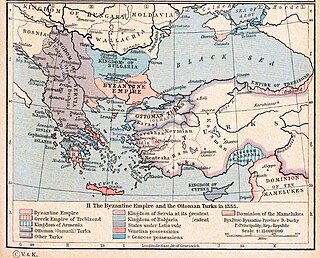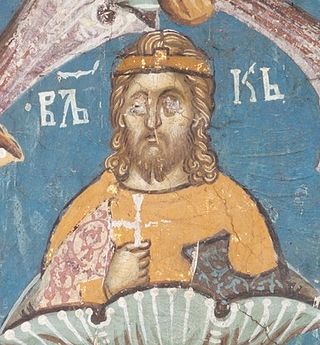Dukljan or Dukljanin (Serbian Cyrillic : Дукљан or Дукљанин) is a figure in Serbian mythology [1] that is a reflection of the Roman emperor Diocletian. [1] He is presented as the adversary of God, [1] possibly because of the real Diocletian's persecution of Christians. [2]
Legends attribute to him building of the town of Duklja, [1] Dukljan's border, [1] and the Roman milestones near Tuzi (according to a folktale, he was throwing them at his brother and sister as they were fleeing to Hum). [1]
A Serbian folk song about Dukljan says that he once removed the Sun from the sky and brought it to the Earth. [1] Saint John managed to trick him and restore the Sun, but afterwards, while chasing him, Dukljan grabbed at him and tore a piece of flesh from John's foot, which explains why humans have arches of the foot. [1]
Several variants of a story that he is still alive exist; according to them he is chained in the Morača river near Duklja (the Vizier's bridge). [1] In some of them, he constantly gnaws at his chains, and each year around Christmas (or around Đurđevdan) nearly manages to break free and destroy the world, when four Gypsy blacksmiths reforge the chains. [1]

Diocletian, nicknamed Jovius, was Roman emperor from 284 until his abdication in 305. He was born Diocles to a family of low status in the Roman province of Dalmatia. Diocles rose through the ranks of the military early in his career, eventually becoming a cavalry commander for the army of Emperor Carus. After the deaths of Carus and his son Numerian on a campaign in Persia, Diocles was proclaimed emperor by the troops, taking the name Diocletianus. The title was also claimed by Carus's surviving son, Carinus, but Diocletian defeated him in the Battle of the Margus.

Zachlumia or Zachumlia, also Hum, was a medieval principality located in the modern-day regions of Herzegovina and southern Dalmatia. In some periods it was a fully independent or semi-independent South Slavic principality. It maintained relations with various foreign and neighbouring powers and later was subjected to Kingdom of Hungary, Kingdom of Serbia, Kingdom of Bosnia, and at the end to the Ottoman Empire.

Duklja was a medieval South Slavic state which roughly encompassed the territories of modern-day southeastern Montenegro, from the Bay of Kotor in the west to the Bojana River in the east, and to the sources of the Zeta and Morača rivers in the north. First mentioned in 10th– and 11th century Byzantine chronicles, it was a vassal of the Bulgarian Empire between 997 and 1018, and then of the Byzantine Empire until it became independent in 1040 under Stefan Vojislav who rose up and managed to take over territories of the earlier Serbian Principality, founding the Vojislavljević dynasty. Between 1043 and 1080, under Mihailo Vojislavljević, and his son, Constantine Bodin, Duklja saw its apogee. Mihailo was given the nominal title King of Slavs by the Pope after having left the Byzantine camp and supported an uprising in the Balkans, in which his son Bodin played a central part. Having incorporated the Serbian hinterland and installed vassal rulers there, this maritime principality emerged as the most powerful Serb polity, seen in the titles used by its rulers. However, its rise was short-lived, as Bodin was defeated by the Byzantines and imprisoned; pushed to the background, his relative and vassal Vukan became independent in Raška, which continued the fight against the Byzantines while Duklja was struck with civil wars. Between 1113 and 1149 Duklja was the centre of Serbian–Byzantine conflict, with members of the Vojislavljević as protégés of either fighting each other for power. Duklja was then incorporated as a crown land of the Grand Principality of Serbia ruled by the Vukanović dynasty, subsequently known as Zeta, remaining so until the fall of the Serbian Empire in the 14th century.
The House of Vojislavljević was a Serbian medieval dynasty, named after archon Stefan Vojislav, who wrested the polities of Duklja, Travunia, Zahumlje, inner Serbia and Bosnia from the Byzantines in the mid-11th century. His successors, kings Mihailo I Vojislavljević and Constantine Bodin expanded and consolidated the state. During the 12th century, the main line of the Vojislavljević family was ousted by their cadet branch, the Vukanović. (which became the Nemanjić dynasty), in the late 12th century.
Constantine Bodin was a medieval king and the ruler of Duklja, the most powerful Serbian principality of the time, from 1081 to 1101, succeeding his father, Mihailo Vojislavljević.

Serbia in the Middle Ages refers to the medieval period in the history of Serbia. The period begins in the 6th century with the Slavic migrations to Southeastern Europe, and lasts until the Ottoman conquest of Serbian lands in the second half of the 15th century. The period is also extended to 1537, when Pavle Bakić, the last titular Despot of Serbia in Hungarian exile, fell in the Battle of Gorjani.

Vukan Nemanjić was the Grand Prince of the Grand Principality of Serbia from 1202 to 1204. He was the Grand Prince of Pomorje from 1195 until his death. He was the eldest, but his father had instead chosen his younger brother Stefan as heir, as soon as his father died, he plotted against his brother, Stefan Nemanjić, and took the throne by force, in a coup assisted by the Kingdom of Hungary. He was defeated two years later, and was pardoned by his third brother, who became Saint Sava, and he continued to rule his appanage of Zeta unpunished.

Mihailo Vojislavljević was a medieval Serbian king and the ruler of Dioclea (Duklja), from 1046 to 1081 initially as a Byzantine vassal holding the title of protospatharios, then after 1077 as nominally serving Pope Gregory VII, addressed as "King of the Slavs". He had alienated himself from the Byzantines when he supported a Bulgarian Uprising of Georgi Voyteh, after which he then sought to gain support in the West. In 1077 he received a royal insignia by Gregory VII in the aftermath of the Church schism of 1054.
Stefan Vojislav was the Prince of Duklja from 1018 to 1043. Beginning in the year 1018, he served as a Byzantine governor, until 1034 when he led an unsuccessful revolt that landed him in a prison at Constantinople. He managed to escape and returned home, this time successfully gaining the independence of his statelet and expanding his rule over southern Dalmatia and its hinterland. He is the eponymous founder of the Vojislavljević dynasty.

George I Vojislavljević or Đorđe Bodinović was a King of Duklja (Zeta) and Travunija, from 1113 to 1118, and again from 1125 to 1131. He also briefly ruled over inner Serbia. He was a son of King Constantine Bodin, of the Vojislavljević dynasty.
Gradinja or Gradihna was the ruler of Duklja, from either 1131 to 1142 or 1135 to 1146. Gradinja is one of many persons mentioned only in the Chronicle of the Priest of Duklja (CPD), not found in Byzantine sources as the other Serbian rulers and royalty. Gradinja was the son of Dukljan prince Branislav, and the brother of Grubeša, the former ruler.

Kosara or Cossara was a Bulgarian noblewoman, related to Tsar Samuel of Bulgaria, who was married to Prince Jovan Vladimir of Duklja.

The Bulgarian-Serbian wars were a series of conflicts between the Bulgarian Empire and medieval Serbian states between the 9th and 14th centuries in the central Balkans.

The Battle of Bar took place on October 7, 1042 between the army of Stefan Vojislav, the Serbian ruler of Duklja, and Byzantine forces led by Michaelus Anastasii. The battle was actually a sudden attack on the Byzantine camp in the mountain gorge, which ended in the utter defeat of the Byzantine forces and the deaths of 7 of their commanders (strategoi). Following the defeat and retreat of the Byzantines, Vojislav ensured a future for Duklja without imperial authority, and Duklja would soon emerge as the most significant Serb state.
Vukan I was the Grand Prince of Serbia from 1083 until he died in 1112. During their first years he ruled together with his brother Marko. With the death of his uncle, King Constantine Bodin of Duklja in 1101, he became the most powerful ruler among Serbian princes. He defeated the Byzantines several times, conquering parts of northern Macedonia. He is the eponymous founder of the Vukanović dynasty.

Zeta was one of the medieval polities that existed between 1356 and 1421, whose territory encompassed parts of present-day Montenegro and northern Albania, ruled by the Balšić family from 1356.

Grand Principality of Serbia, also known by anachronistic exonym as Rascia, was a medieval Serbian state that existed from the second half of the 11th century up until 1217, when it was transformed into the Kingdom of Serbia. After the Grand Principality of Serbia emerged it gradually expanded during the 12th century, encompassing various neighboring regions, including territories of Raška, modern Montenegro, Herzegovina, and southern Dalmatia. It was founded by Grand Prince Vukan, who initially served as regional governor of the principality, appointed by King Constantine Bodin. During Byzantine-Serbian wars Vukan gained prominence and became self-governing ruler in inner Serbian regions. He founded the Vukanović dynasty, that ruled the Grand Principality. Through diplomatic ties with the Kingdom of Hungary, Vukan′s successors managed to retain their self-governance, while also recognizing the supreme overlordship of the Byzantine Empire, up to 1180. Grand Prince Stefan Nemanja (1166–1196) gained full independence and united almost all Serbian lands. His son, Grand Prince Stefan was crowned King of Serbia in 1217, while his younger son Saint Sava became the first Archbishop of Serbs, in 1219.

Jovan Vladimir or John Vladimir was the ruler of Duklja, the most powerful Serbian principality of the time, from around 1000 to 1016. He ruled during the protracted war between the Byzantine Empire and the Bulgarian Empire. Vladimir was acknowledged as a pious, just, and peaceful ruler. He is recognized as a martyr and saint, with his feast day being celebrated on 22 May.